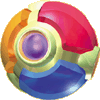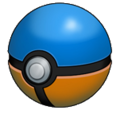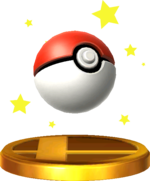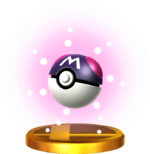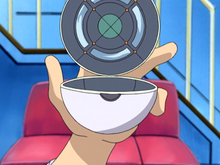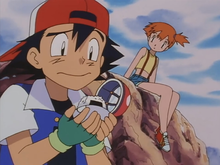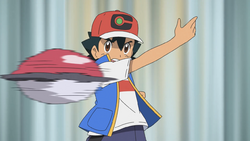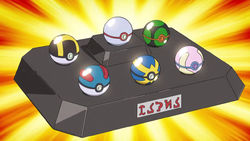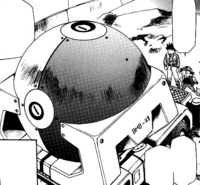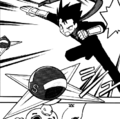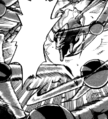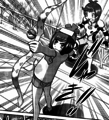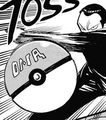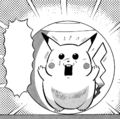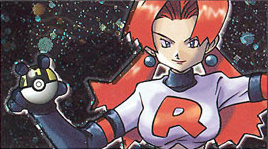Poké Ball
| This article is a featured article. This means that it has been identified as one of the best articles produced on Bulbapedia. |
- This article is about the type of item. For the item called Poké Ball, see Poké Ball (item).
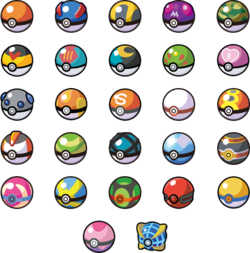
A Poké Ball (Japanese: モンスターボール Monster Ball) is a type of item that is critical to a Trainer's quest, used for catching and storing Pokémon. Both a general term used to describe the various kinds as well as a specific term to refer to the most basic among these variations, Poké Balls are ubiquitous in the modern Pokémon world.
Up to six Pokémon can be carried with a Trainer in Poké Balls, while more Poké Balls can be held in the Bag for later use. These six Pokémon in the Poké Balls can be attached to the user's belt for carrying them around. Some Pokémon do not like to be carried around in Poké Balls, such as Ash's Pikachu.
Stylized Poké Balls are used in many places to symbolize Pokémon in general: the logos of the Battle Frontiers, the Pokémon Contests, the Pokéathlon, and the Pokémon Musical all feature a Poké Ball in their design, while several Poké Balls can be seen in every Pokémon Center. The headgear of the protagonists of Kanto, Hoenn, Sinnoh, and Unova-based games feature Poké Ball designs, as do the Bags of the protagonists of Johto-based games. Ethan's headgear is also similar to the top half of an Ultra Ball, and Lucas's Bag prominently features a Poké Ball.
In the core series games
The strength of a Poké Ball is determined by how much it raises a wild Pokémon's catch rate, and may in fact vary depending on the conditions of the battle. Poké Balls limit the power of Pokémon contained inside, taming them, though they do not cause the Pokémon inside to always obey the Trainer.
History
- Main article: History of Poké Balls
The invention of Poké Balls occurred in the Johto region, where Apricorns grow; these fruit were cut apart and carved out, then fitted with a special device, and used to catch wild Pokémon. Some Trainers still use Poké Balls made from Apricorns, while Kurt, a resident of Azalea Town, still constructs them. Pokémon Legends: Arceus shows that the first settlers of the Sinnoh region, back when it was known as the Hisui region, used pre-modern Poké Balls made of Tumblestone and Apricorns, with Professor Laventon claiming they were a more recent invention. According to Professor Elm, before the invention of the Poké Ball, people would walk with their Pokémon.
In the games, in the Memory Link event A New Light, Drayden claims that Poké Balls did not exist during his childhood.
Modern Poké Balls are not normally made from Apricorns, with the exception of specialist Poké Balls such as the Moon Ball. Modern Poké Balls are manufactured by Silph Co., the Devon Corporation, and the Kalos Poké Ball Factory.
Mechanics and design
Though the technology behind a Poké Ball remains unknown and has evolved through the centuries to accommodate the diverse requirements of their creators, the basic mechanics are simple enough to understand and tend to remain constant: in a Pokémon battle, once an opposing wild Pokémon has been weakened, the Pokémon Trainer can throw a Poké Ball at it. When a Poké Ball hits the Pokémon, as long as it is not deflected, the Poké Ball will open, cause the Pokémon to shrink, store it inside, and close. A Pokémon in this state is given a chance to struggle to attempt to break free from the ball and escape, being instantly growing back in size. Should a Pokémon escape a Poké Ball, the device is destroyed in the games (unlike in the anime). A Pokémon who does not escape the Ball will be caught. Pokémon Legends: Arceus elaborates a bit on how the Pokémon are contained in a Poké Ball, with Professor Laventon explaining that Pokémon have the ability to reduce their size to miniscule, and Poké Balls take advantage of this to contain them.
Poké Balls are specifically constructed for Pokémon capture, transport, and training. As well as being physically difficult to escape from (as they seal tightly shut as soon as a Pokémon is taken into them) the environment of a Poké Ball is designed to be attractive to Pokémon also; according to Lucian of the Sinnoh Elite Four, weakened Pokémon instinctively curl up tight in an attempt to heal themselves, an action that the environment of the Poké Ball encourages. Furthermore, while it is not known how caught Pokémon perceives their time inside their Ball, the device is said to replicate a "Pokémon-friendly" environment that is "designed for comfort". All of these factors strongly discourage Pokémon from escaping their Balls. In the manga, Bugsy refers to his "capture net" as being the net that is supposedly inside a Poké Ball, but visible and already deployed. According to Kurt, this invisible net captures and physically stores a Pokémon.
When a Trainer Dynamaxes or Gigantamaxes a Pokémon, the Poké Ball expands to the size of an association football.
In some games, a Ball Capsule can be used in combination with Seals to create special effects when the Pokémon is sent out.
Poké Ball accuracy
- See also: Catch rate
In some scenarios, a Poké Ball can miss the wild Pokémon completely (in contrast to breaking if the Poké Ball does not successfully capture the Pokémon):
- In the Generation I games, it was possible for a ball to miss the Pokémon when the likelihood of catching the Pokémon in question was particularly low—rather than the ball throwing animation playing and the ball wiggling zero times, a message would come up stating "You missed the Pokémon!".
- In the Generation I games and Pokémon FireRed and LeafGreen, the ghosts in Lavender Town's Pokémon Tower dodge any ball thrown at them before being unmasked by the Silph Scope. The Marowak ghost will dodge all Poké Balls even if it is unmasked.
- In Pokémon: Let's Go, Pikachu! and Let's Go, Eevee!, and in Pokémon Legends: Arceus outside of battle, Poké Balls are thrown manually, and the player must aim properly to hit the Pokémon. Some Poké Balls, namely the Heavy Ball and Feather Ball lines, have noticeably different throwing distances and trajectories compared to the standard variations.
In other scenarios, it is simply not possible to use Poké Balls in the first place:
- In the Generation I and II core series games, if both the player's party and their current Box are full, the player cannot throw a Poké Ball.
- In the core series games, in wild battles the player cannot throw a Poké Ball if there are multiple opponents—such as in wild Double Battles, Horde Encounters, or SOS Battles—with the game claiming that it's impossible to aim.
- This is not the case in Pokémon Legends: Arceus.
- From Pokémon Diamond and Pearl onward, it is not possible to throw a Poké Ball if the opposing Pokémon is in the semi-invulnerable turn of a move (such as Fly or Dig).
- Starting in Generation V, in Double and Triple Battles, it is not possible to issue a command to one Pokémon and then throw a Poké Ball as the second Pokémon's turn. However, it is still possible to throw a Poké Ball if one Pokémon is in the middle of a two-turn move.
- In Black 2 and White 2, Ghetsis uses his cane to control a wild Kyurem and orders it to attack the player. The cane also emits signals that disrupt the use of empty Poké Balls, preventing Kyurem from being captured during the climax.
- In Sun, Moon, Ultra Sun, and Ultra Moon, the player is forbidden from throwing Poké Balls at wild Pokémon in a trial site until the trial has been cleared.
- In Sun, Moon, Ultra Sun, and Ultra Moon, a signal that prevents the use of empty Poké Balls is broadcast throughout Aether Paradise to protect the Pokémon living there. This prevents the player from capturing the wild Nihilego that attacks them on their first visit to the facility.
- In Ultra Sun and Ultra Moon, the player cannot use a Poké Ball on a Necrozma that has fused with a Solgaleo or Lunala.
- In Pokémon Sword and Shield, the player cannot catch a Pokémon whose level is above the limit the player's current Badges can allow. Such Pokémon is described as "very strong-looking".
- In The Crown Tundra expansion, the player cannot catch Spectrier or Glastrier during the encounter with it in the village because "It won't let its guard down!"
- In Pokémon Brilliant Diamond and Shining Pearl, the player cannot catch the Origin Forme Giratina encountered inside the Distortion Room in Ramanas Park.
- In Pokémon Legends: Arceus, the player cannot catch certain Pokémon, including noble Pokémon and Arceus.
- In Pokémon Scarlet and Violet, the player cannot throw a Poké Ball at a wild Tera Pokémon until it is sufficiently weakened, breaking through its transformation.
Types of Poké Balls
In the Pokémon games so far, there have been 34 (38 if the Hisuian Poké Ball, Great Ball, Ultra Ball, and Heavy Ball are considered distinct from their modern-day counterparts) different varieties of Poké Balls, all differing from each other in some way, whether it be an increased ability to catch a Pokémon from the wild or an effect which occurs only after the Pokémon has been caught. From Generation III onward, each variety of Poké Ball has a unique animation when it sends out a Pokémon (and also when it catches one prior to Generation VI), and the type of Poké Ball used to catch the Pokémon is preserved on its summary screen.
Prior to Generation VI, all hatched Pokémon are in a standard Poké Ball. In Generation VI, a bred Pokémon will be in the same Poké Ball as its mother, unless its mother was in a Cherish Ball or Master Ball, in which case the Pokémon will be in a standard Poké Ball; Pokémon bred from a male or gender-unknown Pokémon and Ditto will hatch in a standard Poké Ball. Since Generation VII, Pokémon bred from a male and a Ditto inherit the father's ball as well, and if two Pokémon of the same species in different balls are bred, the resulting offspring will be in either the mother's or father's ball. This also applies if the parents are different regional forms. Much like the Cherish Ball or Master Ball, the Strange Ball introduced in Generation VIII cannot be inherited and resulting offspring will be in standard Poké Balls.
Regardless of type of Poké Ball, Fling will fail if the user is holding one.
Starting in Generation III, each type of Poké Ball has an index number associated with it that is stored in the data structure of the Pokémon when caught or otherwise obtained a given type of ball. Generation I and II did not store this data, resulting in any Pokémon transferred from Virtual Console via Poké Transporter being placed into standard Poké Balls. Pokémon caught in Park Balls within Pal Park will retain their original Poké Ball and index number from Generation III. Pokémon originating from Pokémon Legends: Arceus which are then transferred into another game, (vice versa for those caught outside Legends: Arceus and then transferred in), will be displayed in Strange Balls while visiting a game where the Pokémon's ball is not programmed into the game, but will still retain its original index number. Pokémon originating from Legends: Arceus visiting Pokémon Sword and Shield will temporarily have their ball converted into a standard Poké Ball, with their original ball data being stored in Pokemon HOME's server.
Every Poké Ball (except the Beast Ball and Master Ball) has a 0.1× catch rate modifier when attempting to catch an Ultra Beast.
| Name | Gen. | Index # | Hex | Catch rate modifier | Notes | |
|---|---|---|---|---|---|---|
| Poké Ball | I | 4 | 04 | 1× | Must be in the player's Bag with an empty space in the party to obtain a Shedinja when Nincada evolves from Generation IV onwards. | |
| Great Ball | I | 3 | 03 | 1.5× | ||
| Ultra Ball | I | 2 | 02 | 2× | ||
| Master Ball | I | 1 | 01 | 255× (guaranteed capture) | The only Poké Ball other than the Beast Ball that does not have a 0.1× catch modifier when used on an Ultra Beast. | |
| Safari Ball | I | 5 | 05 | 1× | Prior to Generation VIII, it was only usable within Safari Zones. | |
| Fast Ball | II | 17 | 11 | 4× if used on a Pokémon with a base Speed of at least 100 1× otherwise |
In Generation II, it was intended to have a 4× catch modifier for Pokémon that can flee, but it only does for three of them: Magnemite, Grimer and Tangela. | |
| Level Ball | II | 18 | 12 | 1× if the player's Pokémon is the same level as or a lower level than the wild Pokémon 2× if the player's Pokémon is at a higher level than the wild Pokémon but less than double it 4× if the player's Pokémon is more than double but less than four times the level of the wild Pokémon 8× if the player's Pokémon is of a level four times or more than that of the wild Pokémon |
||
| Lure Ball | II | 19 | 13 | 4× if used on a Pokémon encountered while fishing 1× otherwise |
||
| Heavy Ball | II | 20 | 14 | -20 if used on a Pokémon weighing 220.2 lbs. (99.9 kg) or less ±0 if used on a Pokémon weighing 220.5 lbs. (100.0 kg) – 440.7 lbs. (199.9 kg) +20 if used on a Pokémon weighing 440.9 lbs. (200.0 kg) – 661.2 lbs. (299.9 kg) +30 if used on a Pokémon weighing 661.4 lbs. (300.0 kg) or more |
In Pokémon Crystal only, there is a glitch that causes the retrieved weights of Pokémon whose index numbers are divisible by 64 (Kadabra, Tauros, and Sunflora) to become junk data that are, in turn, interpreted as massive weights, causing these particular Pokémon to receive the +40 capture modifier. In Pokémon Sun and Moon only, a Heavy Ball will always fail to catch a Pokémon whose weight is less than 220.46 lbs (100.0 kg) and whose catch rate is less than or equal to 20. This is because the game will set the catch rate to 0 when the catch rate becomes negative due to the -20 modifier that is applied. | |
| Love Ball | II | 21 | 15 | 8× if used on a Pokémon of the same species but opposite gender of the player's Pokémon 1× otherwise |
In Generation II, it has an 8× catch modifier if both Pokémon are the same species and gender. | |
| Friend Ball | II | 22 | 16 | 1× | Sets caught Pokémon's friendship to 200Gen II-VII, or 150Gen VIII+ | |
| Moon Ball | II | 23 | 17 | 4× if used on a Pokémon that evolves by using a Moon Stone 1× otherwise |
In Generation II, it always has a 1× catch modifier due to a programming error. | |
| Sport Ball* | II | 24 | 18 | 1× | Prior to Generation VIII, it was only usable during the Bug-Catching Contest. | |
| Net Ball | III | 6 | 06 | 3.5× if used on a Water or Bug-type Pokémon 1× otherwise |
||
| Dive Ball | III | 7 | 07 | 3.5× if used on a water-dwelling Pokémon 1× otherwise |
In Generation III, it only had an increased catch rate underwater. | |
| Nest Ball | III | 8 | 08 | ((41 - Pokémon's level) ÷ 10)× if Pokémon's level is between 1 and 29 1× otherwise |
||
| Repeat Ball | III | 9 | 09 | 3.5× if used on a Pokémon that is registered in the player's Pokédex as caught 1× otherwise |
||
| Timer Ball | III | 10 | 0A | (1 + number of turns passed in battle * 1229/4096)×, maximum 4× at 10 turns | ||
| Luxury Ball | III | 11 | 0B | 1× | Doubles the rate at which the contained Pokémon's friendship increases. | |
| Premier Ball | III | 12 | 0C | 1× | ||
| Dusk Ball | IV | 13 | 0D | 3× if used in a cave or at night 1× otherwise |
||
| Heal Ball | IV | 14 | 0E | 1× | Fully restores a caught Pokémon's HP and PP and removes their status conditions. | |
| Quick Ball | IV | 15 | 0F | 5× if used on the first turn of a battle 1× otherwise |
||
| Cherish Ball | IV | 16 | 10 | 1× | Unobtainable by the player, but used for various event Pokémon. | |
| Park Ball | IV | 27 | 1B | 255× (guaranteed capture if used in Pal Park) 1× otherwise |
Unobtainable by the player, but used in Pal Park. | |
| Dream Ball | V | 25 | 19 | 4× if used on a sleeping Pokémon 1× otherwise |
Used only in Entree Forest prior to Generation VIII. Catch rate modifier 255× (guaranteed capture) in Generation V. | |
| Beast Ball | VII | 26 | 1A | 5× if used on an Ultra Beast 0.1× otherwise |
If any other Poké Ball (except the Master Ball) is used on an Ultra Beast, it has a 0.1× catch modifier. | |
| Strange Ball | VIII | 27 | 1B | 0.75× | Unobtainable by the player. Pokémon in Pokémon Legends: Arceus that were transferred from other games via Pokémon HOME, as well as Pokémon from Legends: Arceus in Pokémon Brilliant Diamond and Shining Pearl or Pokémon Scarlet and Violet will be displayed in this ball. | |
| Poké Ball (Hisui) | VIII | 28 | 1C | 0.75× | ||
| Great Ball (Hisui) | VIII | 29 | 1D | 1.5× | ||
| Ultra Ball (Hisui) | VIII | 30 | 1E | 2.25× | ||
| Feather Ball | VIII | 31 | 1F | 1× 1.25× when boosted |
Can be thrown further than a regular Poké Ball. Is more effective for catching Pokémon that fly high in the air. | |
| Wing Ball | VIII | 32 | 20 | 1.5× 1.75× when boosted |
Can be thrown further than a Feather Ball. Is more effective for catching Pokémon that fly high in the air. | |
| Jet Ball | VIII | 33 | 21 | 2× 2.75× when boosted |
Can be thrown further than a Wing Ball. Is more effective for catching Pokémon that fly high in the air. | |
| Heavy Ball (Hisui) | VIII | 34 | 22 | 1× 1.25× when boosted |
Doesn't fly far, but is more effective if the Pokémon hasn't noticed the player. | |
| Leaden Ball | VIII | 35 | 23 | 1.75× 2× when boosted |
Upgraded version of the Heavy Ball. Doesn't fly far, but is more effective if the Pokémon hasn't noticed the player. | |
| Gigaton Ball | VIII | 36 | 24 | 2.5× 2.75× when boosted |
Upgraded version of the Leaden Ball. Doesn't fly far, but is more effective if the Pokémon hasn't noticed the player. | |
| Origin Ball | VIII | 37 | 25 | N/A | Automatically catches Origin Forme Dialga or Palkia at the end of the main story in Pokémon Legends: Arceus. | |
| All details are accurate to Generation VIII games. For details that have changed between generations, please see an individual item's page. | ||||||
Other variants
- The GS Ball is an event item that appears only in Pokémon Crystal, where it was part of a giveaway on the Mobile System GB for Japanese games, similar to event items given out via Nintendo Wi-Fi Connection and Nintendo Network from Generation IV onward. It was not used to catch any Pokémon and was placed in the Key Items pocket. If given to Kurt for inspection, it will activate an event where the player can catch a Celebi in Ilex Forest.
- A few sprites in the Generation III core series games have off-color Poké Balls due to sprite palette limitations. While they are most likely intended to be standard Poké Balls, their color scheme is sometimes distinct from the usual color scheme.
- When transferring Pokémon via Poké Transfer, a blue-colored Poké Ball is used to catch the Pokémon in the minigame. They are shot using a bow.
- In the Timegate Traveler Series featured in Pokéstar Studios, the future is ruled by Bug-type Pokémon that capture wild humans in Human Balls (Japanese: ヒューマンボール Human Ball) instead of the other way around. They have no visual difference to Poké Balls.
- In Pokémon Sword and Shield, the Dynamax Band allows Trainers to increase the size of Poké Balls, making them look like giant Premier Balls.
- When a Pokémon is Dynamaxed (including Gigantamaxing) with a Dynamax Band, the Trainer returns their active Pokémon to its Poké Ball, then turns the Poké Ball into a giant Poké Ball. This giant Poké Ball is then thrown, sending out the Dynamax Pokémon.
- In Max Raid Battles and Dynamax Adventures, when the wild Dynamax Pokémon is defeated, the Trainer turns an empty Poké Ball into a giant Poké Ball, then throws it at the wild Dynamax Pokémon in an attempt to catch it.
Glacia with a yellow Poké Ball
Concept art of a giant Poké Ball for Dynamax by Ken Sugimori[1]
Item balls
- Main article: Item → Obtaining items
Items contained in Poké Balls have been present from the very first games, with many items that are found on the field being found in Poké Balls in conspicuous locations. These items are sometimes important, and usually will be among the required items for pickup along the way. Sometimes, even Poké Ball variants can be found in item balls, though it may be that the item ball itself is supposed to represent the ball that is found. Many other items, however, are hidden, and are not in item balls, instead being directly on the field, and can be found more easily using an Itemfinder or Dowsing Machine.
Voltorb, Electrode, Foongus, Amoonguss, and Galarian Stunfisk appear as item balls in the overworld, but attack when interacted with (or if at close range for Galarian Stunfisk), except the Foongus in Accumula Town. In Pokémon: Let's Go, Pikachu! and Let's Go, Eevee!, fake item balls appear upside down.
Game icons
Poké Balls are often featured in the icons for Pokémon games, which are used on the home screens for the Nintendo DS, 3DS, and Switch.
| D P | Pt | HG SS | B W | B2 W2 | X Y | OR AS | OR AS (Demo) |
S M | S M (Demo) |
US UM | Transporter | Bank | HOME |
In the side series games
Pokémon Colosseum and XD: Gale of Darkness
In Pokémon Colosseum and Pokémon XD: Gale of Darkness, a Snag Ball is not a single, separate type of Poké Ball, but rather any type of existing Poké Ball that has been "unlocked" by the Snag Machine, allowing it to snag an already-caught Pokémon during a battle. While it is able to be used on any Pokémon, Rui will only allow Wes to use it on Shadow Pokémon, while Michael's Aura Reader will render the Snag Machine inoperable when a Pokémon other than a Shadow Pokémon is targeted.
It is possible to snag a Shadow Pokémon even if there are two on the opposing side of the field, unlike catching Pokémon in the core series games.
In the spin-off games
Pokémon GO
Players do not battle wild Pokémon in Pokémon GO, and using Poké Balls is a matter of the player's aim. To throw one, the player must press their finger on the Poké Ball, move it, and release it. The Ball and Pokémon exist in a 3D environment, so the player may miss the Pokémon by throwing the Ball the wrong distance or too far to the side. Additionally, the wild Pokémon may attempt to dodge or attack every few seconds. When a Pokémon is attacking, any Poké Balls that hit it will be deflected. When a Pokémon dodges, it will move around but can still be hit by a thrown Ball.
- See more: Caught Pokémon → Pokémon GO
On the aiming screen, a colored circle displays over the Pokémon, gradually shrinks to nothing, then resets to its widest before continuing to shrink again. If the player's throw lands inside this circle, they will get a "Nice!", "Great!", or "Excellent!" catch chance bonus depending on how small the circle was. The player can also improve their catch chance by throwing a curveball. If the player spins the Ball while holding it, it will temporarily retain the spin and curve left or right when thrown.
- See more: Catch rate (GO)
Three types of Poké Balls were available in Pokémon GO upon release: regular Poké Balls, Great Balls, and Ultra Balls. These remain the only types of Poké Balls that are generally available. They can be repeatably obtained by:
- Spinning PokéStops or Gyms (Lv. 12+ for Great Balls and Lv. 20+ for Ultra Balls)
- Opening a Gift (Lv. 12+ for Great Balls and Lv. 20+ for Ultra Balls)
- Completing certain Field Research or Special Research tasks
- Weekly Adventure Sync rewards
The player also receives Poké Balls upon leveling up.
- Poké Balls awarded up to level 11 (including 50 Poké Balls starting at level 1)
- Great Balls awarded from level 12 to level 19
- Ultra Balls awarded starting level 20
Regular Poké Balls may be purchased in the Shop at the following rates:
All three types of balls have also been available in limited-time Box deals.
Premier Balls debuted in Pokémon GO on June 20, 2017,[citation needed] a few days after its first anniversary with the introduction of Raid Battles. They can only be used for catching Raid Bosses and Shadow Pokémon, and other types of Poké Balls cannot be used on them. If the player runs out, the Raid Boss or Shadow Pokémon will flee. The number of Premier Balls are awarded to the player after a Raid Battle or Team GO Rocket battle is based on how well they battled. Unused Premier Balls are not retained and do not roll over to future challenges. Like in the main series, Premier Balls are just as effective as regular Poké Balls.
Beast Balls debuted in Pokémon GO on July 1, 2022 at Pokémon GO Fest 2022 Berlin.[citation needed] They can only be used for catching Ultra Beasts, and other types of Poké Balls cannot be used on them. Currently, an unlimited number of Beast Balls are provided to the player during an Ultra Beast encounter.
Master Balls have existed in Pokémon GO's coding since release, but they didn't debut until May 22, 2023, as a reward from the Let's GO! Special Research. Future opportunities to get Master Balls are planned.[2]
Description
| Image | English name | Japanese name | Description |
|---|---|---|---|
| Poké Ball | モンスターボール Monster Ball |
A device for catching wild Pokémon. It's thrown like a ball, comfortably encapsulating its target. | |
| Great Ball | スーパーボール Super Ball |
A high-performance Ball with a higher catch rate than a standard Poké Ball. | |
| Ultra Ball | ハイパーボール Hyper Ball |
An ultra-performance Ball with a higher catch rate than a Great Ball. | |
| Master Ball | マスターボール Master Ball |
The best Poké Ball with the ultimate level of performance. With it, you will catch any wild Pokémon without fail. | |
| Premier Ball | プレミアボール Premier Ball |
A somewhat rare Poké Ball made to commemorate a special occasion of some sort. | |
| Beast Ball | ウルトラボール Ultra Ball |
N/A |
Pokémon Snap
In Pokémon Snap, the Pester Balls appear similar to Poké Balls at a glance. However, they are not used to catch Pokémon, and instead will release a Pokémon repellent on contact.
Pokémon UNITE
In Pokémon UNITE, Trainers use regular Poké Balls to send out their own Pokémon, after they have been knocked out in battle. (At the start of a Unite Battle, all Pokémon are present on the field.) During the game's tutorial, a Pikachu from the Aeos Research Institute is sent out from a Poké Ball twice. This happens before Tutorial (Basics 1) and Tutorial (Basics 2).
A unique variety of Poké Ball, the Unite Ball, is used as part of Unite Battles. (They are also known as Aeos Balls) Unite Balls are orange, purple, and yellow in colour, with a yellow stripe around in the middle and a white button. The pattern gives the Unite Ball a "U" design. Each Trainer has a Unite Ball, and uses it to catch the wild Pokémon their Pokémon knocks out in Unite Battles. After doing so, the Unite Ball stores the Aeos energy the Pokémon held. The stored energy is used by Pokémon to score at goal zones. At the start of an Unite Battle, the player's Unite Ball only holds a maximum of 30 Aeos energy. After their Pokémon reaches Level 9, the capacity increases to 40. At level 12, the capacity is boosted again to 50. Trainers only have one Unite Ball canonically, and the interface only depicts a single Unite Ball. Regardless, Trainers throw a Unite Ball for every wild Pokémon defeated even if more than one is defeated at the same time.
In Mer Stadium's Catch 'Em battles, certain wild Pokémon have a white glow around them. When these Pokémon are defeated and captured, the player can send them out from their Unite Ball to temporarily take the place of their selected Pokémon. This function replaces the Trainer's Battle Items. Additionally, after enough time has passed, the Battle Item will return to normal and that Pokémon will not be able to be switched into battle. If the captured Pokémon is sent out, a timer is set. When that timer elapses or the Pokémon faints, the Trainer's original Pokémon is sent back into battle from its Poké Ball. Defeating a Wild Pokémon while currently using a Caught Pokémon does not allow the player to switch to the defeated Wild Pokémon.
In Panic Parade, certain wild Pokémon have a white glow around them and a Aeos Ball icon over their heads. When these Pokémon are defeated and captured, the player can send them out from their Unite Ball. This function replaces the Trainer's Battle Item, and after using the Battle Item will return to normal. (Although "normal" in Panic Parade means no Battle Item at all.) If another item is picked up or another capturable Pokémon is captured, the first Pokémon is lost. The sent out Pokémon wanders to the nearest opposing Pokémon, uses their Unite Move, then is recalled and leaves the battle.
Unite Balls (mislabeled Poké Balls) are used as part of the Prize Machine menu. By throwing Unite Balls at one of the items on display, the prize gauge for that item is increased. When the prize gauge of an item is full, the item is obtained. A single Unite Ball has a 66% chance to add 1 unit to the prize gauge, a 30% chance to add 2 units to the prize gauge, a 3.3% chance to add 3 units, a 0.6% chance to add 5 units, and a 0.1% chance to add 10 units. Players have two Unite Balls to use in this menu. After using a Unite Ball, players must wait 12 hours before it can be used again. Players can spend Aeos gems to hasten this timer. Some events provide additional Unite Balls in the Prize Machine menu, under the umbrella name No-cost Holiday Balls. When available, only 10 of these Poké Balls can be obtained per day, and they are lost if they are not used before the next day begins. Usually there is a cap on the number of No-cost Holiday Balls obtainable per event, with that cap usually being 100. Sometimes, these additional Unite Balls have alternate names, such as Holiday Balls or Anniversary Balls. (Oddly, the menu's text states that "Poké Balls always hit their target..." in this mode, even though Unite Balls have never been shown to miss in any media.)
Pokémon Pinball series
- Main article: Ball Upgrade (Pinball)
In Pokémon Pinball and Pokémon Pinball: Ruby & Sapphire, the Poké Ball, Great Ball, Ultra Ball, and Master Ball are available.
The Poké Ball is the normal ball used in the pinball tables since the beginning of the game. In both games, if the player lights up the three Field Multiplier Lanes found in all tables, the ball is upgraded to the next kind of Poké Ball (a Poké Ball is upgraded into a Great Ball, a Great Ball into an Ultra Ball, and an Ultra Ball into a Master Ball). If a minute passes without new Poké Ball upgrades, the ball returns to the previous state. If the player loses a ball, the next ball is a Poké Ball.
The bonus points are as follows:
- The Poké Ball has no bonus multiplier.
- The Great Ball multiplies bonus points by ×2.
- The Ultra Ball multiplies bonus points by ×3.
- The Master Ball multiplies bonus points by ×4 in Pokémon Pinball and by ×5 in Pokémon Pinball: Ruby & Sapphire.
Pokémon Pinball
| Poké Ball | Great Ball | Ultra Ball | Master Ball |
Pokémon Pinball: Ruby & Sapphire
| Poké Ball | Great Ball | Ultra Ball | Master Ball |
Learn with Pokémon: Typing Adventure
In Learn with Pokémon: Typing Adventure, the Typing Balls are thrown after one successfully types a Pokémon's name. It has the overall design like that of a normal Poké Ball, only having an additional vertical line at the bottom, resembling the letter "T".
Super Smash Bros. series
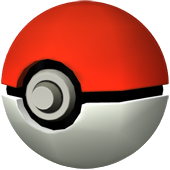
In the Super Smash Bros. series, Poké Balls appear as items, which fighters can pick up and throw to release a random Pokémon. These Pokémon will typically attack the opponents of the player who summoned them, but may also have other effects. Starting in Super Smash Bros. for Nintendo 3DS/Wii U, the Master Ball also appears as an item, which has the same effect as Poké Balls but can only summon Legendary or Mythical Pokémon (or Goldeen).
The Pokémon that can appear from Poké Balls differ between the games. The Poké Ball Pokémon in Super Smash Bros. all come from Generation I, the Poké Ball Pokémon in Super Smash Bros. Melee come from up to Generation II, the Poké Ball Pokémon in Super Smash Bros. Brawl come from up to Generation IV, the Poké Ball Pokémon in Super Smash Bros. for Nintendo 3DS/Wii U come from up to Generation VI, and the Poké Ball Pokémon in Super Smash Bros. Ultimate come from up to Generation VII. The only Pokémon that have appeared in all of the Super Smash Bros. games as Poké Ball Pokémon are Goldeen, Snorlax, and Mew.
The Pokémon series as a whole is represented by a Poké Ball logo in the Super Smash Bros. series. The logo was updated in Brawl.
Super Smash Bros. Melee
- Poké Ball trophy
- These balls are used to catch and contain wild Pokémon. Most Pokémon must be weakened in some way before they can be caught, but once they're inside a Poké Ball, they enjoy their new home, since Poké Balls contain an environment specially designed for Pokémon comfort. Master Balls are the strongest type.
Super Smash Bros. Brawl
- Poké Ball trophy
- "An item used for capturing Pokémon and calling them out into battle. Pokémon live in these items which despite appearances, actually contain a wide, comfortable Pokémon-friendly world inside them. In Super Smash Bros., Pokémon give temporary support to who calls them out. You never know which you will get, but some are devastatingly powerful."
Super Smash Bros. for Nintendo 3DS/Wii U
- Poké Ball trophy
- NA: An item used to call out different Pokémon. Which Pokémon emerges is a mystery, but it will aid whoever threw the Poké Ball. Some of the Pokémon contained inside are extremely powerful and will really intensify the battle. It's definitely worth beating your opponents to these!
- PAL: A ball holding one of any number of Pokémon just waiting to burst out and help you in battle. Which kind will it be? Well, that's a surprise, but whichever one it is, it'll definitely up the intensity of the battle! If you see one, make sure you're the one to grab it!
- Master Ball trophy
- NA: These valuable, powerful balls can capture any wild Pokémon. In Smash Bros., hard-to-find Pokémon often pop out of them. You can easily identify a Master Ball by the distinct purple appearance and large M on the top. A Pokémon within a Master Ball may turn the tide of battle.
- PAL: A rare type of Poké Ball that never fails to catch a Pokémon. Throw one in this game, and the Mythical or Legendary Pokémon inside will come to your aid. Master Balls are easy to identify due to their purple colour and the large M on them. Use one to quickly turn the tide of any battle!
Pokémon Tower Battle
In Pokémon Tower Battle, the featured Pokémon come from Poké Balls, with some rare Pokémon from Ultra Balls and Master Balls.
In the anime
Main series
Mechanics
In the anime, Poké Balls are not always at full size. Pressing the button on the front will convert it between its full size, about the size of a baseball, to a smaller size, about that of a ping-pong ball, and back again. The larger size makes throwing the ball easier, while the smaller one makes for easier storage on a belt clip, in pockets, and in Bags.
When a Pokémon is sent out from a Poké Ball, it will be accompanied by a distinctive sound effect and a bright light as it returns from its energy form and materializes nearby, often on the ground. This bright light has been shown to vary depending on the type of Ball in which the Pokémon is contained in the games, while it has always been shown to be white in the anime. Pokémon are recalled to their Poké Ball by holding up the Poké Ball with its button pointed at the Pokémon. A beam of red, white, or blue light will shoot from the button, converting the Pokémon back into energy and returning it to the Ball. The beam, however, has a limited range and can be dodged by the Pokémon. If the beam hits a person, they will be stunned for a moment, but aside from that, no ill effects will make themselves apparent.
Releasing a Pokémon from a Trainer's ownership, unlike normally sending the Pokémon out, will bathe the Pokémon in a blue glow, and the Poké Ball will no longer mark it, making it able to be caught by another Trainer's Poké Ball.
A Poké Ball can also be broken, which will release it from ownership, as seen when Jessie releases her Dustox in Crossing Paths. If a Trainer has done so accidentally, it must somehow be fixed before the Pokémon can be recalled. This was seen in Pokémon Food Fight!, where Ash becomes unable to recall Snorlax after its Poké Ball is broken. In the manga, if a Poké Ball is broken before a Pokémon is sent out, then that particular Pokémon cannot be used until their Poké Ball has been repaired. This happened several times in the Pokémon Adventures manga, such as during Red's battle against Giovanni, where the opening mechanism for the Poké Balls of Red's Venusaur and Gyarados were damaged, preventing either of them from being used in the match.

Pokémon appear to be conscious while inside Poké Balls. Several Pokémon have shown the ability to leave and return to their Poké Balls at will, most notably among them Jessie's Wobbuffet, Misty's Psyduck, Ash's Oshawott, Brock's Croagunk, and Clemont's Chespin, who tend to do so in every episode that they appear in. In Dig Those Diglett!, many Pokémon belonging to Gary Oak, as well as other Trainers, including Ash Ketchum, demonstrated the ability to prevent themselves from being sent from their Poké Balls, as they refused to fight against the Diglett, though this has not been demonstrated since. Pokémon have also been shown to be able to hear orders given by their Trainer right before they are sent out.
Pokémon can even make their Poké Ball jump and roll around at high speeds, while also being able to navigate, as seen in Pokémon: Let's Go, Pikachu! and Let's Go, Eevee!, when the partner Pokémon moves its Poké Ball onto an empty pedestal in Professor Oak's Laboratory after being caught in Pallet Town.
Poké Balls are able to communicate with a Trainer's Pokédex, as the system updates itself with information on newly-caught Pokémon, and keeps track of how many Pokémon the Trainer has with them. If a Trainer catches a new Pokémon with the full six already with them, the Pokédex will automatically send the newly-caught Pokémon in its Poké Ball to the Pokémon Storage System that the Trainer is using. As shown in Two Degrees of Separation!, a Pokémon caught by a Poké Ball is "marked" by it, and thus most Poké Balls thrown at it will have no effect aside from temporarily stunning it. In the games, as well as in Bad to the Bone, however, the Trainer of the Pokémon will block a Poké Ball thrown by another, though it is possible that this is more out of courtesy to their Pokémon than to prevent capture outright. In Charmander – The Stray Pokémon, Ash was able to catch his Charmander in a Poké Ball despite his previous ownership by another Trainer, though he may have lost his "mark" when he abandoned his previous Trainer by refusing to return to his old Poké Ball. Earlier in the same episode, Ash failed to catch the same Charmander while he still held his loyalty, despite his weakened state.
Other wireless capabilities of Poké Balls are shown in Destiny Deoxys, as when the electricity of the city is down, Rebecca claims that the "Poké Ball Management System" was no longer working without power. A similar mechanism is suggested to exist in the games, with the Paradise Protection Protocol issuing a lock signal that disables the use of any Poké Balls that do not have a specific ID.
Poké Balls are able to be decorated to no ill effect, with several Poké Balls that have been painted with special colors being seen in the anime.
Should a Pokémon escape a Poké Ball, the device will return to the Trainer, who can attempt once again to catch the Pokémon.
It has sometimes been shown that items can be contained in Poké Balls, apparently able to be captured in much the same way as a Pokémon. The anime has used this as a gag on several occasions, most notably in Primeape Goes Bananas, where Ash accidentally catches a rice ball when he throws a Poké Ball in an attempt to catch a wild Mankey.
Types of Poké Ball

In the anime, the basic Poké Ball is the most commonly used of all varieties, with other varieties appearing either very few times or not at all. A vast majority of Pokémon are shown to be stored in regular Poké Balls, to the point that large collections of Poké Balls can be seen with no variation among them. Even Ash's Pikachu, the most prominent Pokémon in the anime which spends all its time outside with Ash, has a plain Poké Ball that differs from others only by the small yellow lightning bolt symbol on it, as seen in Pokémon - I Choose You!.
Despite this, the various other types of Poké Ball have been seen in the anime, usually to illustrate a special property about that particular ball. The lack of the different types is unsurprising, however, due to the fact that, when the anime was first created, the games themselves did not even keep track of the Poké Ball that a Pokémon was caught in, and thus, it made no difference in sending a Pokémon out. This has recently become less common as of Pokémon the Series: Sun & Moon, possibly to reflect the fact that NPC Trainers in Generation VII have certain types of Poké Balls associated with them.
The first time that a Poké Ball aside from the normal variation was seen was in EP035, where Ash was given 30 Safari Balls in order to compete in the Safari Game. With these 30 Safari Balls, Ash attempted to catch various rare Pokémon; however, he only managed to capture an entire herd of Tauros. They appeared in Safari Balls in Showdown at the Po-Ké Corral; however, whenever Ash uses one of his Tauros in a battle, it is sent out from a standard Poké Ball.
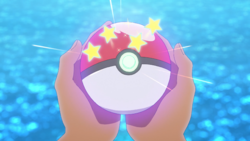
The GS Ball was the second of the variant Poké Balls to appear in the anime, this time with a special purpose. This mysterious ball was unable to be opened by Professor Ivy, and served as the reason for Ash's journeys to the Orange Archipelago (to pick it up) and Johto (to deliver it to Kurt), so that what was contained within it could be discovered. Celebi was long rumored to be related to the ball, something which the Pokémon Adventures and game canons verify, while a director of the anime confirmed that, had it not been insisted that Celebi appear in a central role in the fourth movie, the GS Ball arc would have concluded with Celebi being released from the ball and traveling with Ash and his friends.
Also related to Kurt, as in the games, the first non-standard Poké Ball variants, the Apricorn balls, made an appearance in the anime, and several were given to the members of the main cast. All three members of the main cast received a Fast Ball each in Going Apricorn!, with Brock using his to catch a Pineco shortly after receiving it. Many other Apricorn Poké Balls also appeared in a fantasy in this episode. In the next episode, Brock received a Heavy Ball, while Ash and Misty received a Lure Ball each. While Brock's Heavy Ball and Ash and Misty's Fast Balls would remain unused (and have not been mentioned since), both Ash and Misty would use their Lure Balls to capture a Totodile and Corsola, respectively. Another Heavy Ball appeared in Gulpin It Down, where it was used to capture a giant Gulpin, though this was not the one belonging to Brock. In Trouble's Brewing, the Kimono Sisters (excluding Sakura) were shown keeping their Eeveelutions inside Apricorn Poké Balls, with Satsuki's Jolteon's ball being a Moon Ball, Sumomo's Vaporeon's ball being a Lure Ball, and Tamao's Umbreon's ball being a Fast Ball. While Koume's Flareon's ball wasn't shown, her kimono pattern indicates it being a Love Ball.
The Master Ball itself has only appeared once as an actual Poké Ball, in Whiscash and Ash, where it was used by Sullivan in a last resort attempt to catch a wild Whiscash called "Nero". Despite the fact that a Master Ball cannot be escaped from, the Whiscash swallowed the Master Ball, thus preventing capture, and disappeared back into the water. While not a Poké Ball itself, Misty owns a beach ball that is designed like the Master Ball, which can be seen in Beauty and the Beach and A Hot Water Battle.
The Generation III specialty balls have mostly been seen in cameos. The Repeat Ball and Luxury Ball appeared in the opening of Jirachi: Wish Maker. These balls contained Brendan's Shiftry and Aggron, respectively.
The debut of most of the specialty balls, both from Generation III and IV, came in the ending Which One ~ Is It?, which contained the first appearance of the Great Ball and Ultra Ball, as well as the first anime appearance of the Premier, Heal, Net, Dusk, Nest, Quick, Timer, and Dive Balls.
The first proper appearance of the Great, Ultra, Net, Nest, Dusk, Dive, Repeat, Premier, and Heal Balls was in A Frenzied Factory Fiasco!, where these balls were seen being manufactured at the Poké Ball Factory, in addition to normal Poké Balls, Luxury Balls, and Safari Balls, although the last ones were not shown. Although James did mention a Quick Ball in the Japanese version, one was never shown in the episode (a fact that was picked up by the dub, which removed the Quick Ball reference). Team Rocket tried to steal many of these Poké Balls, but were foiled by Ash and his friends.
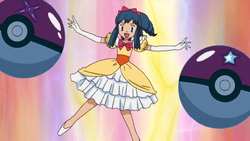
It was revealed in First Catch in Alola, Ketchum-Style! that James had been collecting Poké Balls. When Jessie's attempts to catch a Mimikyu with typical Poké Balls had failed, she grabbed the Luxury Ball James had been polishing and used it instead, capturing Mimikyu, much to James's dismay. The rest of James's collection appeared in Acting True to Form!, where it was revealed to also contain a Great, Ultra, Premier, Dusk, Heal, and Quick Ball, marking the first proper anime appearance of a Quick Ball. The collection reappeared in Splash, Dash, and Smash for the Crown!, where it now consisted of a Premier, Dive, Nest, Quick, Heal, and Dusk Ball.
Gladion keeps all of his known Pokémon in special Poké Balls. His Lycanroc is kept in an Ultra Ball (as first seen in A Glaring Rivalry!), his Silvally is kept in a Premier Ball (as first seen in Rising from the Ruins!), his Umbreon is kept in a Heal Ball (as first seen in Rescuing the Unwilling!), his Zoroark is kept in a Dusk Ball (as first seen in the Poké Problem extra scene of SM127), and his Nihilego is kept in a Beast Ball (as first seen in The Homecoming Crown!).
Beast Balls debuted in A Mission of Ultra Urgency!, in which the Aether Foundation provided multiple of them for Ash and his classmates to use during their missions as Ultra Guardians. Since then, Beast Balls have appeared in a number of episodes. Most of the time they are only used to temporarily hold Ultra Beasts until they are released back into Ultra Space. The only Ultra Beasts that have been kept in a Beast Ball for longer than one episode are Ash's Naganadel and Gladion's Nihilego.
In Sword and Shield... The Legends Awaken!, Leon used an Ultra Ball in an attempt to catch Eternatus, only for Eternatus to break out.
Many other Poké Balls have been shown in the anime; however, most of these are cosmetic alterations alone, such as Poké Balls with gold plating, diamond studded Poké Balls, and Poké Balls with stickers or special designs on them, usually to denote an organization. Ball Capsules and Seals can also be used to customize a Poké Ball's appearance, and they add special effects when the Pokémon is sent out. In the anime, they are mostly used by Coordinators during Pokémon Contests to create a showy entrance and ensure that the Pokémon will make a good impression right out of the Poké Ball.
Notably, a broken Poké Ball, snapped in half at its rusted hinges, was kept by both Ash and Gary, symbolizing their rivalry. After Ash defeated Gary during the Silver Conference, Gary gave his half of the Ball to Ash as a sign of ending their rivalry.
In Mystery at the Lighthouse, it was shown that if a Trainer catches a Pokémon while they already have six on hand, it is automatically sent to the regional Professor. Sewaddle and Burgh in Pinwheel Forest shows a major difference in what happens after a Pokémon is captured. Instead of being automatically sent to the regional Professor, the Poké Ball is sealed and the button becomes red. The Pokémon is kept inactive until it is switched out by another actively in the Trainer's party.
Other variants
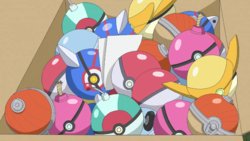
- A green Poké Ball appeared in Pokémon - I Choose You!. Interestingly, the cover of the book Grass Pokédex greatly resembles this Poké Ball, and is labeled as a Safari Ball.
- In addition to this, the artwork of Brendan, in Ruby and Sapphire, features Brendan holding a green Poké Ball.
- Several objects were used to contain and control Pokémon before Poké Balls themselves were developed. Large monumental objects have been shown several times in episodes to be containers for large ancient Pokémon, as seen most notably in The Ancient Puzzle of Pokémopolis. Smaller objects have also been used, such as the staff belonging to Sir Aaron, which contained his partner, Lucario, until Ash released it in the current era. Special armor developed by Marcus was used to control Pokémon in ancient Michina Town, though it did not directly contain the Pokémon; unlike other methods of using Pokémon, these Pokémon were enslaved, instead of befriended, and they turned against him the moment the armor was broken.
- Mewtwo had a collection of strange Poké Balls known as (Japanese: ミュウツーボール Mewtwo Balls) in Mewtwo Strikes Back, which incorporated an eye into their design, and were used primarily to capture Pokémon to be cloned. These balls had no trouble catching Pokémon which were already captured—even if they were already inside of Poké Balls.
- In Spell of the Unown: Entei, Molly Hale, whose imagination caused the power of the Unown to change the world around them, was able to use strange, crystalline Poké Balls when she challenged Brock and Misty. The Pokémon sent from these appeared normally, but dissolved into crystal, rather than being recalled. These crystal Poké Balls only appeared when used by her imagined older selves, and do not appear to actually exist.
- A special variant of Poké Ball, the Lake Ball, was used during the Seaking Catching Competition in Hook, Line, and Stinker; this is viewed by many to be similar to the Sport Ball used in the Bug-Catching Contest. They appear as blue and white Poké Balls, with a fish pattern around the edge, and a yellow arrow on the top and bottom of the ball. They don't shake after capture, implying an automatic catch.
- In One Trick Phony!, specially marked Poké Balls appeared at the Battle Park, containing the Park's rental Pokémon. They looked almost exactly like standard Poké Balls, except that they had the Park's stylized "BP" logo on the top.
- Older Poké Balls have also appeared in the anime, specifically the one carried by Sam in Celebi: The Voice of the Forest, which was colored differently, and it had a knob that needed to be twisted before the Pokémon inside could be sent out. While it is unknown how these types were manufactured, it is likely that they were made by hand using Apricorns, prior to the standardization and mass production of modern-day Poké Balls.
- The Iron-Masked Marauder, an agent of Team Rocket, used special Dark Balls that corrupted Pokémon caught inside them and made them into mindless servants of the Trainer, as well as raising their power significantly. Multiple Pokémon were caught in these Poké Balls, including the Mythical Celebi and a powerful Tyranitar. They seem capable of catching any Pokémon without fail.
- As in the games, the GS Ball appeared in the anime, and was the primary motivation for Ash's trip to the Orange Islands, where he would compete in his second Pokémon League. It also served as the catalyst for his journey to Johto, as he needed to deliver the ball to Kurt. Former director Masamitsu Hidaka revealed that a shelved storyline, that would have concluded the GS Ball's arc, involved a Celebi that would have traveled with Ash and his friends through at least part of Johto. The storyline was viewed as redundant after the decision was made to introduce Celebi in the fourth movie instead.
- Claydol, Big and Tall featured the "Stone Ball", a huge Poké Ball made of stone used to keep an evil, giant Claydol that levied destruction everywhere. This Poké Ball is about the size of a two-story house.
- In Battling the Enemy Within!, an ancient relic resembling a Poké Ball was first mentioned by Brandon, who told Ash and his friends a story about the King of Pokélantis, who had once tried to control Ho-Oh for his own evil purposes. When Ash later found the relic, it was revealed that the King of Pokélantis's spirit was actually sealed within it, and it possessed Ash until it was banished from his body and resealed back inside the relic.
- In A Fishing Connoisseur in a Fishy Competition!, a specially marked Poké Ball, called the "Fishing Poké Ball", was used in the fake fishing contest set up by Team Rocket. This Poké Ball highly resembled the regular red and white Poké Ball, except that it had a dark fish mark on its red part.
- In The Power of Us, the participants of the Pokémon Catch Race used special "Catch Race Poké Balls" to catch specifically marked Pokémon around Fula City. These Poké Balls feature a blue-and-white color scheme, with a gold button.
- In Pokémon Journeys: The Series, starting from Ivysaur's Mysterious Tower!, the Team Rocket trio was provided with the Rocket Prize Master, a vending machine that lets them borrow random Pokémon from it, contained in special Team Rocket Poké Balls. When a Pokémon is sent out from them, these Balls drop a small leaflet explaining details about the Pokémon in question.
- Dynamaxed Poké Balls were first used in Flash of the Titans! during Lance and Leon's World Coronation Series battle. In Sword and Shield... The Legends Awaken!, Goh, with Ash's help, used a Dynamaxed Poké Ball to catch a weakened Eternatus, which was later sealed away.
- In HZ029, several custom-made Poké Balls created by Khana were shown. These include the Rocket Ball, which has miniature rocket engines that boost its speed; the Boomerang Ball, which curves back around once thrown; the Bomb-Bomb Ball, which has a fuse that lights up when the ball is about to be thrown and causes the ball to explode when it burns out; the Chase Ball, which homes in on the target Pokémon on a set of wheels; and an unnamed Ball that Khana gave to Orla as a gift at the end of the episode.
A green Poké Ball in Pokémon - I Choose You!
The Poké Ball containing Bulbasaur in Pokémon - I Choose You!
The Poké Ball containing Charmander in Pokémon - I Choose You!
The Poké Ball containing Squirtle in Pokémon - I Choose You!
The Poké Ball containing Pikachu in Pokémon - I Choose You!
A diamond-encrusted Poké Ball in Go West Young Meowth
Mewtwo's Mewtwo Balls
Molly Hale holding a Crystal Poké Ball
The Lake Ball from Hook, Line, and Stinker
Lokoko's old Poké Ball from Just Waiting On a Friend
A Poké Ball used in the Battle Park in One Trick Phony!
A Team Rocket Ball from Mewtwo Returns
Iron-Masked Marauder holding a Dark Ball
Sammy's old Poké Ball from Celebi: The Voice of the Forest
Annie and Oakley's Poké Balls from Pokémon Heroes: Latios & Latias
A promotional toy version of Annie and Oakley's Poké Balls, produced by Tomy
Claydol's giant stone Poké Ball from Claydol, Big and Tall
A relic holding the King of Pokélantis's spirit
A Fishing Poké Ball from A Fishing Connoisseur in a Fishy Competition!
A Catch Race Poké Ball from The Power of Us
Team Rocket Balls from Pokémon Journeys: The Series
A Dynamaxed Poké Ball in Sword and Shield... The Legends Awaken!
A Rocket Ball from HZ029
A Boomerang Ball from HZ029
A Bomb-Bomb Ball from HZ029
A Chase Ball from HZ029
One of Khana's custom Poké Balls from HZ029
History
- Main article: History of Poké Balls
As mentioned, the generic Poké Ball design is not constant and has been remodeled and altered innumerable times in order to create new Poké Balls that are adapted for specific conditions. For example, it is seen in several anime episodes such as Gulpin it Down! and Claydol Big and Tall that normal Poké Balls have difficulty catching Pokémon which are extremely large or extremely heavy. In the latter episode, it is revealed that ancient civilizations overcame this issue by constructing immense Poké Balls many times the size of the standard model known today, and made from stone instead. Other civilizations such as Pokémopolis also discovered new technologies that more closely resembled modern Poké Ball technology, such as the Dark Device and the Unearthly Urn, which were also adapted for the capture and storage of massive Pokémon but in small containers. However, devices like these became lost to the ages and their roles were subsequently supplanted by Heavy Balls in the modern world.
In A Shipful of Shivers, modern Poké Balls are found in the ghost ship, implying that modern Poké Balls were first made at least 300 years ago. According to Pocket Monsters: The Animation, Poké Balls were developed to allow for various Trainers to efficiently capture and train Pokémon in relatively little risk to themselves, as the act of training a Pokémon often results in severe injuries and even death. It also claims that the Pokémon Primeape and its notoriously violent nature was directly responsible for their creation.
Prior to the invention of Poké Balls, Pokémon were referred to as magical creatures (Japanese: 魔獣 majū), indicating that the name Pokémon, short for Pocket Monster, did not come into common parlance as a term until Poké Balls allowed the various magical creatures to be stored easily.
Pokédex entries
|
Ancient Poké Ball
The search for these Poké Balls is an important plot within Pokémon Horizons: The Series. These Poké Balls, in addition to capturing Pokémon, seem to have unique powers and react to certain stimuli, like Liko's pendant and other Ancient Poké Balls.
History
Roy is in possession of an antique Poké Ball that he refers to as the Ancient Poké Ball. It was found by his grandfather and later given to him. It first appeared in The Treasure After the Storm!, where Roy mentioned how he had never managed to open it. In The Ancient Poké Ball, the ball reacted with Liko's pendant and opened to reveal a Shiny Rayquaza that flew away soon after. The ball is said to have belonged to an ancient adventurer who once commanded Rayquaza. In HZ011, another identical Ancient Poké Ball appeared under the possession of a giant Arboliva. In the next episode, this Poké Ball was revealed to be Arboliva's, and to have been owned by the ancient adventurer as well.
Pokémon housed in Ancient Poké Balls
| Pokémon | Region | Debut |
|---|---|---|
 Black Rayquaza |
Kanto* | The Ancient Poké Ball |
 Giant Arboliva |
Paldea | Nemona and Brassius and… |
 Galarian Moltres |
Galar | Charge! Galar Mine! |
 Lapras |
Unknown | HZ031 |
Gallery
Settei of Roy's Ancient Poké Ball from Pokémon Horizons: The Series
Pokémon Origins
Besides the regular Poké Ball, the other Generation I variations of it were also seen during the Pokémon Origins miniseries. In File 3: Giovanni, it was shown that Giovanni kept his strongest Pokémon, Rhyhorn and Rhydon, within Ultra Balls. In File 4: Charizard, Red was seen catching an Arbok with a Great Ball and a Chansey with a Safari Ball. He also used Ultra Balls to capture the Legendary Pokémon Articuno, Zapdos, Moltres, and Mewtwo.
The Master Ball only appeared in a demonstration in File 3: Giovanni, as it was still under development at the time. After Team Rocket was driven out of the Silph Co. building by Red, the development of the Master Ball was put on hold for a while.
Additionally, in Pokémon Origins, the sound effects and bright light used when a Trainer is catching, sending out, or recalling a Pokémon differ in comparison to the sound effects and lights that are used in the main Pokémon anime, more resembling the effects seen in Pokémon FireRed and LeafGreen.
Pokémon Generations

The only Poké Ball variant seen in Pokémon Generations was an Ultra Ball, which appeared in The Scoop. It was shown being used by a Trainer to catch a Deoxys in outer space.
In the manga
In the various Pokémon manga, Poké Balls have been shown to appear differently, as an attempt to explain how a Trainer knows which Pokémon is in which ball, as most Pokémon manga series were, like the anime, developed at a time when the games could not keep track of the ball a Pokémon was contained in.
The Electric Tale of Pikachu

In The Electric Tale of Pikachu, the rules are more similar to the anime; however, Poké Balls are numbered on the outside, on the button, so that a Trainer knows which member of their team they are sending into battle. In The Electric Tale of Pikachu, Trainers must obtain a license before they are legally allowed to purchase Poké Balls.
It is also possible for a Pokémon to be placed inside a Poké Ball without it being owned by a Trainer. In Days of Gloom and Glory, Meowzie steals a Poké Ball from a shop and puts her kitten in it so that it will not be hurt by a flood affecting the city.
In Haunting My Dreams, a giant Poké Ball named the Enormo Poké Ball-X1 (Japanese: ビッグモンスターボールX1 Big Monster Ball-X1) or EPB-X1 for short, was created to capture the gigantic Haunter, Black Fog. It was destroyed when the Black Fog used Explosion to free itself after being captured.
Magical Pokémon Journey
In Magical Pokémon Journey, the main characters generally do not capture Pokémon, rather, they befriend them. Although Almond, one of the main characters, is known to be a Pokémon Trainer, he is not actually depicted capturing or raising any Pokémon. In fact, in the bonus materials of Volume 2, in which the cast of the manga meet Ash, Misty and Brock in a series of crossovers, it is revealed that Hazel and Coconut do not even know what Poké Balls are. When Ash and Misty explain that they are used to capture Pokémon, they both proceed to attempt to use them to capture Almond, as he is each of their love interest.
Pokémon Adventures
In the Pokémon Adventures manga, the tops of Poké Balls are semitransparent, allowing the Pokémon inside, which is miniaturized, to be seen through the ball, while the Pokémon can likewise see out of the ball it is contained in. In this manga, unlike in the anime, Pokémon already captured can be recaught in another Poké Ball, as is seen when Red recatches Misty's Gyarados in Gyarados Splashes In! (though Blue states that catching a Pokémon that belongs to another is not possible in Lapras Lazily).
Like in the anime and the games, specialty balls do exist, although they are much more commonly used than in the anime. In Holy Moltres, Team Rocket was shown to have caught the legendary birds in Ultra Balls. In And Mewtwo... Three!, Blaine gave Red the Master Ball, which Red used to catch Mewtwo shortly afterwards. In Teddiursa's Picnic, Gold and Silver received a Friend Ball and Heavy Ball, respectively, with Silver using his ball to catch an Ursaring, while Gold used his to catch a Teddiursa for Maizie. Close to the end of the Gold, Silver & Crystal arc, the Masked Man was shown creating a GS Ball and using it to catch Celebi. In Innocent Scientist, Blake used Luxury Balls while trying to catch the Genesect controlled by Colress, eventually succeeding. In Abyssal Ruins, Blake gave Whitley a Quick Ball to catch a Karrablast. In Scizor Defends, a Quick Ball was seen amongst the Poké Balls that Y had used while trying to catch an Absol.
Safari Balls have been seen being used by Red at the Kanto Safari Zone, by Diamond, Pearl, and Platinum at the Great Marsh, and by Silver at the Johto Safari Zone. Crystal and Emerald have also been shown using special balls to catch Pokémon, with Crystal specializing in Apricorn balls and Emerald specializing in Poké Balls introduced in Generation III.
Additionally, the three original types of Poké Ball are used to identify the Trainer's rank; most Trainers keep their Pokémon in Poké Balls, Gym Leaders use Great Balls, and Elite Four members use Ultra Balls.
In the Sun, Moon, Ultra Sun & Ultra Moon arc, Beast Balls were created for the Aether Foundation by Blake, who was disguised as Colress, as a means of catching Ultra Beasts. Sun used one to catch his Stakataka in Madness!! Mother Lusamine!.
Like in the games, but unlike the anime, Pokémon placed in their balls don't recover from status conditions nor regain lost health, no matter how much time passes.
Variants
- Bruno has modified his Poké Balls so that they are fitted onto the ends of his nunchucks. By swinging them quickly and throwing the nunchuck forward, Bruno can have his Pokémon quickly attack his opponent, giving him the advantage.
- Koga and his daughter Janine modified their Poké Balls into shuriken to fit their ninja theme. In addition to being used as weapons, they can also be used to have their Pokémon pop up from different locations to surprise the opponent or to hold items to help an ally.
- Bugsy had Kurt modify his butterfly net into something he calls a Capture Net. His net has a Poké Ball nested into the middle of it. The bag of the net is made of the same material of the inside of a Poké Ball. Once a Pokémon is covered in the bag, they will automatically be sucked into the Poké Ball.
- Falkner has modified his Poké Balls into boomerangs using the feathers of his Skarmory. Because of Skarmory's feathers being transparent, they have the tendency to turn invisible, confusing enemies when Falkner throws them in random directions only for them to turn around and go straight for them.
- Erika and Moon modified their Poké Balls to be at the end of their arrows.
- In It Takes Patience, Knowledge and a Really Quick Beedrill, Giovanni used a specifically designed Poké Ball with the letters "DNA" on its top half to capture Deoxys.
- Multiple Dynamaxed Poké Balls appeared in the Sword & Shield arc, being used to both capture Dynamax Pokémon and send them out.
Pokémon Gold & Silver: The Golden Boys
Besides regular Poké Balls, Apricorn Poké Balls also received notable attention in the Pokémon Gold & Silver: The Golden Boys manga. They were first featured in The Great Search! Let's Rescue The Slowpoke!, where Gold and Kurt used some of Kurt's hand-made Poké Balls to save a group of Slowpoke from drowning in the flooding Slowpoke Well. Kurt's Level Ball also proved crucial in stopping the Black Tyranitar's rampage during the manga's climax.
Pokémon Gotta Catch 'Em All

In Pokémon Gotta Catch 'Em All, Poké Balls are depicted as solid, with no visual identification as to which Poké Ball is which. In Special Chapter - Get Pikachu!, it is revealed that when Shu met Pikachu, Pikachu's Poké Ball had been abandoned in a forest because it was defective and it was causing Pikachu's electricity to be released throughout the surrounding area.
Pokémon Pocket Monsters
In Pokémon Pocket Monsters, Poké Balls are often shown as transparent to identify when a Pokémon is inside. They usually have their typical appearance from far away, suggesting that they may not always be transparent, or are only see-through from up close. Pokémon appear to be able to see the world outside of their Poké Balls, as shown in Bring Down the Powerful Opponent Onix!!, when Clefairy sees Pikachu inside his Poké Ball, and they talk to each other. In Introducing the Pokémon Clefairy!!, when Green is choosing Charmander as his first partner Pokémon, he is shown to be able to pick up and lift Charmander directly from the Poké Ball without throwing it first.
Red's Pikachu inside his Poké Ball, in his debut appearance
Green's Charmander being lifted from its Poké Ball
In the TCG
Several variants of Poké Ball have been released in card form in the Pokémon Trading Card Game, ranging from the standard variants found in the games and other media to variants specific to the TCG. Generally, Poké Balls are depicted as Item cards that search the player's deck for Pokémon and put them into the player's hand. Many Poké Ball cards require some number of successful coin flips in order to allow for the search to succeed, but some cards use the order of the player's deck to create inconsistency instead. There are even Poké Ball cards that are guaranteed to work, but these cards are balanced by only finding specific subsets of Pokémon, requiring some cost to be paid, or having another drawback.
Some cards, such as Apricorn Maker and Ball Guy, refer to Poké Ball cards as a group, using the phrase "Item cards that have the word “Ball” in their name". This phraseology excludes cards with "Balloon" in their name even though they otherwise meet the criteria. (An example of an excluded card was Bursting Balloon, before the errata that changed Pokémon Tool to be a subtype of Trainer rather than a subset of Items.)
List of Poké Ball cards based on the games
- The standard Poké Ball card, which was the first released, debuted in the Jungle expansion and has since been featured in many others. If a coin flip is successful, it searches the deck for a Pokémon and puts it in the player's hand.
- The Ultra Ball can be seen in the artwork of Rocket's Sneak Attack, from the Team Rocket expansion. The 'H' on this Ultra Ball is derived from its Japanese name, Hyper Ball. The Ultra Ball itself would appear in Dark Explorers, with its effect requiring the player to discard 2 cards from the hand to search the deck for a Pokémon.
- The Great Ball, which first appeared in the TCG expansion coinciding with the remakes of the Generation I games, is somewhat of an upgrade to the Poké Ball, and does not require the coin flip that the Poké Ball does, instead restricting the search to Basic Pokémon. Later, in Emerging Powers, Great Ball's effect was changed to have the player search the top 7 cards of the deck for any one Pokémon card and put it in the hand.
- The Master Ball, first appearing in the Gym Challenge expansion, and in the games the most powerful of the Poké Balls, provides a vastly different effect than the standard. Rather than searching the entire deck, only the top seven cards may be searched. One Pokémon found in these seven can be put into the hand, while the rest must be shuffled back into the deck. In Plasma Blast, the Master Ball was changed to an ACE SPEC card that allowed the player to search the entire deck for any one Pokémon.
- Debuting in the Skyridge expansion, the Lure Ball is different from the basic Poké Balls in that it draws from the discard pile rather than the deck. For each heads flipped, with a maximum of three, an Evolution card can be returned from the discard pile and put into the hand. It has since been reprinted in Celestial Storm.
- Also debuting in Skyridge, the Friend Ball, another Apricorn Ball, has a unique effect entirely, allowing the user to search their deck for a Pokémon of the same type as one of the opponent's Pokémon, making it effective in decks that typically match up well against their own type. It was also reprinted in Celestial Storm.
- The Fast Ball allows the player to go through their deck, turning over cards one at a time until they find the first evolution card, and then taking that into their hand, shuffling afterward. Like the other two Apricorn Balls, it debuted in Skyridge, but unlike the others, it has not appeared since.
- The Premier Ball, debuting in the Great Encounters expansion, is special, much as in the games, and allows the player to search either the deck or the discard pile for a Pokémon LV.X to put into their hand.
- The Luxury Ball, first found in the Stormfront expansion, is among the rarest of the Poké Ball varieties in the games, though its catch rate is the same as that of a normal Poké Ball. Likewise it is so with the TCG, allowing a non-LV.X Pokémon to be searched from the deck, but only if another Luxury Ball card is not in the discard pile.
- The Quick Ball released in the Mysterious Treasures expansion has a similar effect to the Fast Ball released in Skyridge, allowing the player to uncover cards from their deck until they find a Pokémon. An expansion of the Fast Ball's use, any Pokémon can be found, though this may prove an issue if the player is looking for an Evolution card specifically and finds a Basic Pokémon first, and vice versa. The Quick Ball was rereleased in the Sword & Shield expansion with a different effect, requiring players to discard 1 card in order to search their deck for a Basic Pokémon.
- The Dusk Ball, also first found in Mysterious Treasures, features an effect somewhat opposite from the Master Ball's: Instead of the top seven cards being searched, only the bottom seven cards may be, and a Pokémon found there may be put into the player's hand.
- The Heavy Ball, first found in Next Destinies, allows the player to search through their deck for a Pokémon who has a retreat cost of 3 or more and put it in their hand, whereas the Level Ball, also found in Next Destinies, allows them to do the same with a Pokémon that has 90 HP or less.
- The Repeat Ball, found only in Primal Clash, allows the player to search their deck for a Pokémon with the same name as one of their Pokémon in play.
- The Nest Ball, first found in Sun & Moon, allows the player to search their deck for a Basic Pokémon and put it on their bench,
- The Timer Ball, first found in Sun & Moon, allows the player to search their deck for a number of Evolution Pokémon equal to the number of heads from flipping two coins.
- The Net Ball, first found in Lost Thunder, allows the player to search their deck for a Basic
 Pokémon or a
Pokémon or a  Energy card and put it into their hand.
Energy card and put it into their hand. - The Beast Ball, first found in Celestial Storm, allows the player to look at their Prize Cards, and swap an Ultra Beast found there with the Beast Ball card.
- The Cherish Ball, first found in Unified Minds, allows the player to search their deck for any Pokémon-GX and put it into their hand.
- The Dream Ball, first found in Evolving Skies, allows the player to search their deck for a Pokémon and put it on their bench, but the card can only be played if the player took it as a face down Prize card.
- The Feather Ball, first found in Astral Radiance, allows the player to search their deck for a Pokémon with no Retreat Cost and put it into their hand.
- The Hisuian Heavy Ball, first found in Astral Radiance, allows the player to look at their Prize cards, and swap a Basic Pokémon found there with the Hisuian Heavy Ball card.
List of Poké Balls original to the TCG
- The Dual Ball is merely two Poké Balls together, and has a similar effect to using two plain Poké Ball cards, requiring two coin flips to search for up to two Basic Pokémon, depending on how many heads appear.
- The Team Magma Ball is Team Magma's Poké Ball variant, found only in the EX Team Magma vs Team Aqua expansion. It allows the user to search for a Team Magma's Pokémon, but if a coin flip results in tails, the search is limited to Basic Team Magma Pokémon.
- The Team Aqua Ball is Team Aqua's Poké Ball variant, also found only in the EX Team Magma vs Team Aqua expansion. It works exactly the same as the Team Magma Ball, searching for Team Aqua's Pokémon instead.
- The Rocket's Poké Ball is the Team Rocket variation on the Poké Ball, found in the EX Team Rocket Returns expansion. No coin flip is required, and it simply allows the player to search for a Dark Pokémon.
- The Team Plasma Ball is the Team Plasma variant of the Poké Ball, found in the Plasma Freeze expansion. It allows the user to search for a Team Plasma Pokémon without a coin flip required.
- The Team Magma's Great Ball is another Team Magma Poké Ball variant, found in the Double Crisis expansion. It searches the deck for a Basic Team Magma Pokémon and a basic
 energy.
energy. - The Team Aqua's Great Ball is another Team Aqua Poké Ball variant, also found in the Double Crisis expansion. It searches the deck for a Basic Team Aqua Pokémon and a basic
 energy instead.
energy instead.
In the novels
Pocket Monsters: The Animation
In Pocket Monsters: The Animation, it is said that Poké Balls were invented in 1925 by Professor Nishinomori.
In the guidebooks
According to the Encyclopedia Pokemonica, Pocket Monsters Encyclopedia, and a Pokémon Daisuki Club site describing the Pokémon world, modern Poké Balls were developed in 1925 from the research of Professor Westwood of Celadon University.
Trivia
- Professor Oak has written senryū about the Poké Ball in two of his lectures:
- For DP003, the Professor Oak's Big Pokémon Encyclopedia featured this senryū: 「ゲットだぜ なげかたいろいろ モンスターボール」 "I caught a Pokémon! Monster Balls can be thrown in all sorts of ways."
- For BW002, the Professor Oak's Pokémon Live Caster featured this senryū: 「あっポケモン モンスターボール わすれずに」 "Oh, a Pokémon; don't forget to bring your Monster Balls."
- In Pokémon Pinball, the Poké Balls serve as the balls in the machine; they can be used to capture Pokémon and are upgraded depending on the multiplier bonus at the time.
- In some early artwork for Pokémon Red and Green, Poké Balls are shown on the ground in two pieces while the Pokémon are in battle, rather than in the more familiar hinged form they take now. This may be a carryover from when Pokémon was known as Capsule Monsters, as the Poké Ball sprites in Generation I also do not show the button on the ball. In Generation II, Poké Balls split in half when capturing a Pokémon as part of their animation, while the anime had been using the hinge style since the very first episode.
- In the earlier volumes of the Pokémon Adventures manga, Poké Balls captured and released Pokémon in large puffs of smoke, often with a strong sound effect. This may have been based on the capture and release animations in Generation I and II. As Generation III onwards exchanged the smoke effect for Ball-specific animations, the effect in the manga shifted instead to bursts of light.
- Poké Balls are inspired by the capsules for gashapon machines, which contain small, handheld toys.
- In Generation II, after catching a Pokémon, the Poké Ball's color palette changes to that of the Pokémon that was just caught. It then changes back to normal thereafter.
- Starting in Generation III, all Poké Ball types have a special effect that appears whenever the ball is opened. These special effects also can be seen in Pokémon Colosseum and Pokémon XD: Gale of Darkness. In Generation IV and Brilliant Diamond and Shining Pearl, customizable special effects are available through Seals.
- In Pokémon Diamond, Pearl, and Platinum, Cyrus's computer indicates that a Poké Ball would limit the power of Dialga and Palkia. This leads to Team Galactic creating the Red Chain instead to shackle them so they can control their full power.
- Generation VI is the only completed generation to date to not have introduced a new type of Poké Ball.
In other languages
| |||||||||||||||||||||||||||||||||||||||||||||||||||||||||||||||||||||||||||||||||||||||||||||||||||
References
- ↑ Shea, Brian (October 4, 2019). "Exclusive Pokémon Sword And Shield Concept Art Gallery." Game Informer.
- ↑ Never miss with the Master Ball—coming soon to Pokémon GO!
| Types of items | |
|---|---|
| General | Evolution stones • Fossils • Flutes • Shards • Held items Evolution items • Escape items • Exchangeable items • Valuable items Battle items • Scents • Nectars • Candy • Ingredients |
| Medicine | Status condition healing items • Vitamins • Feathers Mints • Mochi • Drinks • Herbal medicine |
| Berry and Apricorn | Poké Balls • Apricorns • Berries • Mulch |
| Aesthetic | Decorations • Accessories (Normal • Great • Ultra • Master) Backdrops • Props • Décor Clothing (XY • SMUSUM • LGPE • SwSh • BDSP • LA • SV) |
| Other | Mail • Key Items • Event items Wonder Launcher items • Rotom Powers |

|
This item article is part of Project ItemDex, a Bulbapedia project that aims to write comprehensive articles on all items. |




![Concept art of a giant Poké Ball for Dynamax by Ken Sugimori[1]](https://archives.bulbagarden.net/media/upload/thumb/0/01/Dynamax_Pok%C3%A9_Ball_Concept_Art.jpg/90px-Dynamax_Pok%C3%A9_Ball_Concept_Art.jpg)


